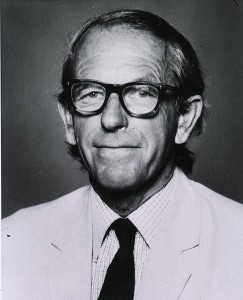![]() Genome Biology was sad to learn of Frederick Sanger’s death on Tuesday, November 19th. Although Sanger retired from scientific research 30 years ago, long before the journal Genome Biology ever started, it is safe to say that without his work we wouldn’t even be here.
Genome Biology was sad to learn of Frederick Sanger’s death on Tuesday, November 19th. Although Sanger retired from scientific research 30 years ago, long before the journal Genome Biology ever started, it is safe to say that without his work we wouldn’t even be here.
The journal was launched in 2001, the same year that the completion of sequencing of the human genome was reported. The sequencing was done entirely using the method Sanger had devised for determining genetic sequences. Although his was not the first technique for reading DNA sequence, it was the first really practical one and, like many methods that revolutionize fields, it was an elegant and conceptually simple idea. Sanger had, in 1977, produced the first whole genome sequence, that of the bacteriophage φX174. From this small beginning, Sanger’s dideoxy sequencing method was routinely used throughout the 1980s and 90s, culminating in the apotheosis of the technique: the determination of all 3 billion bases in the human genome.
 He once wrote that as a scientist he had done everything to avoid two responsibilities that he found unenjoyable: teaching and administrative work. Instead, he preferred good old hands-on research. He credited his scientific achievements to his willingness to be a lab workhorse, saying once:
He once wrote that as a scientist he had done everything to avoid two responsibilities that he found unenjoyable: teaching and administrative work. Instead, he preferred good old hands-on research. He credited his scientific achievements to his willingness to be a lab workhorse, saying once:
“Unlike my scientific colleagues, I was not academically brilliant. […] however, when it came to research where experiments were of paramount importance and fairly narrow specialization was helpful, I managed to hold my own even with the most academically outstanding“.
This, however, is the modesty that only truly academically brilliant people can afford; Sanger wrote these words after the Swedish Academy decided to honor him with the Nobel Prize. Twice.
But tenacity must have played a huge role in his work too; after all, the sequencing of insulin took him a decade. Yesterday one of the former LMB directors remembered Sanger’s advice for one young scientist: the researcher had been told he should try harder. Sanger didn’t believe in eureka moments; scientific progress and discoveries had to come as a result of hard, methodical work. And they did.
Sanger’s work on sequencing of proteins, and then RNA, and finally DNA, was over the years recognized by the Nobel Committee, making him one of only three people to ever win two scientific Nobel Prizes. The history of his career has to left one wondering though: had there been anything left to sequence, would he have been awarded a third time?
The boom in genomics in the last decade has been fueled by next-generation sequencing methods that work on different principles, but Sanger sequencing is still the gold standard for accuracy. These new techniques generate huge volumes of data much more cheaply than Sanger sequencing but are also error-prone. Variants determined by next-generation sequencing methods are always validated using dideoxy sequencing, and Sanger sequencing is still used routinely for low volume sequencing, or to sequence specific loci. The longevity of the method is testament to its power.
No surprise then that so many commentators called Sanger the father of genomics. It is because, ever since the bacteriophage φX174, he had been one.
Comments